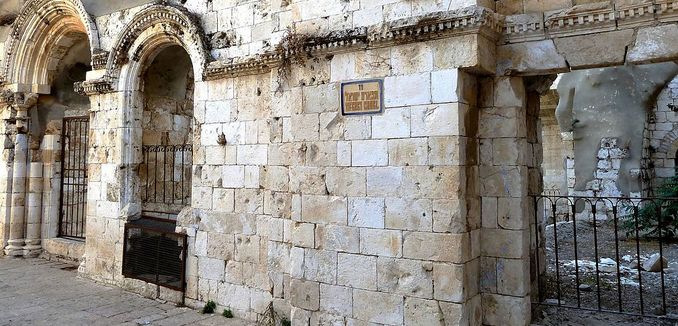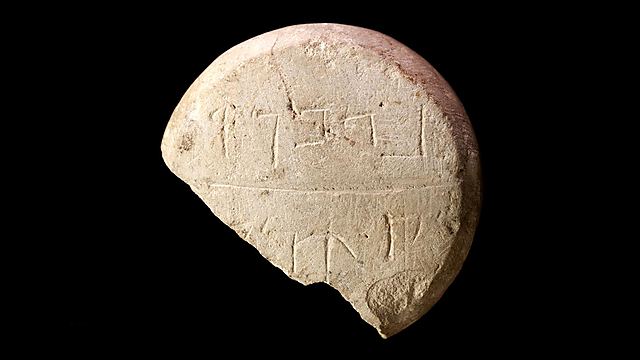A 2,000-year-old scale weight belonging to the family of the Jewish high priest has been discovered by an archaeologist in Jerusalem, Ynet reported Tuesday.
The artifact was located underneath the Tiferet Israel synagogue, which was built in the 18th century and destroyed by Jordan in 1948. Excavations under the synagogue have led to discoveries of artifacts from the Ottoman, Mamluk, and Byzantine periods, as well as from the eras of the two Jewish temples.
Hebrew University archaeologist Oren Gutfield discovered the weight and other artifacts from the Second Temple era about three feet underneath the building’s floor. “It doesn’t happen very much that I get emotional when I find artifacts. But here, I went pale and even felt a small tremble to see the name of the high priest,” Gutfield recounted.
There were two lines of writing on the weight, with the image of a lyre between them. At first the text was obscured by a layer of fire damage, possibly from the burning of Jerusalem in 70 CE. But after further cleaning, the family name of the high priest was readable on the second line. (The first line of writing has not yet been translated.)
A similar weight had been discovered at the Burnt House, a nearby archaeological site. In addition to the weight, Gutfield said, “new mikvehs (ritual baths) that we didn’t know about and their heating system have been uncovered.”
The excavation has been funded by the Company for the Reconstruction and Development of the Jewish Quarter of the Old City of Jerusalem, Ltd., a government-owned company, and has been carried out by archaeologists from the Israel Antiquities Authority (IAA) and Hebrew University.
A number of other recent archaeological finds have also shed light on ancient Jewish life in Jerusalem and the surrounding area. In July, archaeologists uncovered a set of mosaics depicting two scenes from the Hebrew Bible while carrying out excavations at a fifth century synagogue in Israel’s Galilee. In March, two seals bearing Hebrew names were unearthed in the remains of a building from the First Temple period in Jerusalem.
Despite these discoveries and others, there have been attempts to undermine Jewish historical claims to the Temple Mount and Jerusalem, a phenomenon that Israeli Foreign Ministry director-general Dr. Dore Gold has described as “Temple denial.” Tower editor David Hazony wrote in 2007 that “Palestinian leaders, writers, and scholars have embarked on a campaign of intellectual erasure…aimed at undermining the Jewish claim to any part of the land.”
The official Palestinian position—as expressed in the Palestinian National Charter posted on the website of the Palestinian Authority’s United Nations delegation—is that “the claims of historic and spiritual ties between Jews and Palestine are not in agreement with the facts of history or with the true basis of sound statehood.” At the Camp David summit in 2000, then-Palestinian leader Yasser Arafat unsettled President Bill Clinton by denying that there had ever been a Jewish temple in Jerusalem. Arafat’s successor, Mahmoud Abbas, has repeatedly and explicitly lashed out against suggestions that Jews have links to Jerusalem, which is mentioned by name over 600 times in the Jewish bible.
In 1999, while expanding the al-Aqsa mosque, the Jerusalem Islamic Waqf — the religious authority in charge of governing the Temple Mount — dug and removed roughly 400 truckloads of topsoil from the complex, which was then dumped in a landfill at Jerusalem’s Kidron Valley under the cover of night. Israeli archaeologists, who were able to retrieve most but not all of the soil, consequently began to sift it in an effort to recover some ancient artifacts. Among the relics found are thousands of coins from the Second Temple period and the imprint of an ancient Jewish seal.
In 2007, the Waqf used a tractor to dig a 4-foot-deep trench on the northern end of the Temple Mount, allegedly to replace old electric cables. At the time, archaeologist Zachi Zweig said “there is a high probability that ancient remnants were damaged,” among them the foundation of a wall that could have belonged to the Second Temple. That incident led to the formation of the Israeli Committee for the Prevention of Destruction of Antiquities on the Temple Mount, which aims to prevent further damage to ancient artifacts by ongoing renovations at the site.
Three years ago, following the discovery of Jewish treasures in Jerusalem, including a seven-branched menorah, dating to the seventh century, Israeli Prime Minister Benjamin Netanyahu said that the find “attests to the ancient Jewish presence and to the sanctity of the place; this is as clear as the sun and it is tremendous….This is historic testimony, of the highest order, to the Jewish People’s link to Jerusalem, to its land and to its heritage.”
In Discovering Jewish History on the Golan Heights, featured in the May 2014 issue of The Tower Magazine, Stephen Rubin wrote of another archaeological treasure, Umm el Kanatir, and what it tells of Jewish life in the area nearly 1,300 years ago.
[Photo: Djampa / WikiCommons ]





